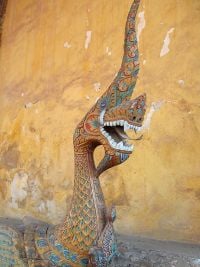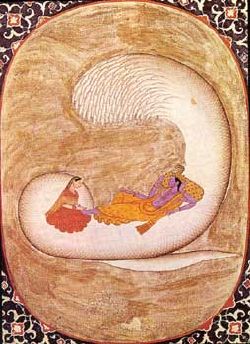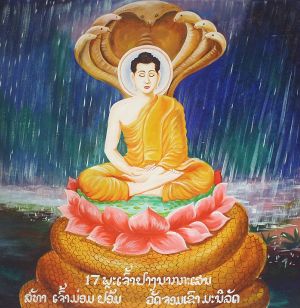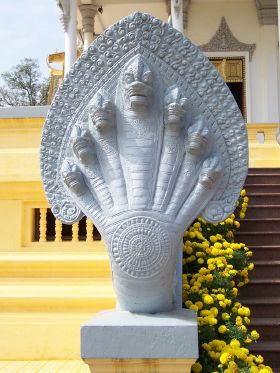Naga
Nāga (Sanskrit:नाग) is the Sanskrit and Pāli word for a deity or class of entity or being, taking the form of a very large snake, found in Hinduism and Buddhism. The use of the term nāga is often ambiguous, as the word may also refer, in similar contexts, to one of several human tribes known as or nicknamed "Nāgas"; to elephants; and to ordinary snakes, particularly the King Cobra and the Indian Cobra, the latter of which is still called nāg in Hindi and other languages of India. A female nāga is a nāgī.
Etymology
In Sanskrit, a nāgaḥ (नागः) is a cobra, a specific type of snake (hooded snake). A synonym for nāgaḥ is phaṇin (फणिन्). There are several words for "snake" in general, and one of the very commonly-used ones is sarpaḥ (सर्पः). Sometimes the word nāgaḥ is also used generically to mean "snake".[1] [2]
Nagas in the Mahabharata
In the great epic Mahabharata, the depiction of Nagas tends toward the negative, and they are portrayed as the deserving victims of the snake sacrifice and of predation by the rapacious bird-man Garuda. The epic calls them "persecutors of all creatures", and tells us "the snakes were of virulent poison, great prowess and excess of strength, and ever bent on biting other creatures" (Book I: Adi Parva, Section 20). At the same time, nagas are important players in many of the events narrated in the epic, frequently no more evil nor deceitful than the other protagonists, and sometimes on the side of good.
The epic frequently characterizes Nagas as having a mixture of human and serpent-like traits. Sometimes it characterizes them as having human traits at one time, and as having serpent-like traits at another. For example, the story of how the Naga prince Sesha came to hold the world on his head begins with a scene in which he appears as a dedicated human ascetic, "with knotted hair, clad in rags, and his flesh, skin, and sinews dried up owing to the hard penances he was practising." Brahman is pleased with Shesha, and entrusts him with the duty of carrying the world. At that point in the story, Shesha begins to exhibit the attributes of a serpent. He enters into a hole in the Earth and slithers all the way to bottom, where he then loads the Earth onto his head. (Book I: Adi Parva, Section 36.)
Garuda and the nagas
The great nemesis of the Nagas in the Mahabharata is the gigantic bird-man Garuda. Garuda and the Nagas began life as cousins. The sage Kasyapa had two wives, Kadru and Vinata, the former of whom desired many offspring, and the latter of whom desired few but powerful offspring. Each got her wish. Kadru laid 1000 eggs which hatched into snakes, and Vinata laid two, which hatched into the charioteer of Surya the sun god and Garuda. Through a foolish bet, Vinata became enslaved to her sister, and as a result Vinata's son Garuda was required to do the bidding of the snakes. Though compliant, he chafed and built up a grudge that he would never relinquish. When he asked the snakes what he would have to do in order to be released from his bondage, they told him he would have to bring them amrita, the elixir of immortality. Garuda stole the elixir from the gods and brought it to the serpents in fulfillment of their requirement, but through a ruse prevented them from partaking of it and achieving immortality. From that point onward, he regarded them as enemies and as food. (Book I: Adi Parva, Sections 16ff.)
The curse of Kadru
Kadru, the ancestral mother of snakes, made a bet with her sister Vinata, the stakes being that the loser would be enslaved to the winner. Anxious to secure victory, Kadru requested the cooperation of her offspring in order to fix the bet so that Kadru would win. When her offspring balked at the request, Kadru grew angry and cursed them to die a fiery death in the snake-sacrifice of King Janamejaya, the son of Parikshit, who was the son of Abhimanyu the son of Arjuna. The king of the snakes Vasuki was aware of the curse, and knew that his brethren would need a hero to rescue them from it. He approached the renowned ascetic Jaratkaru with a proposal of marriage to a snake-maiden, Vasuki's own sister. Out of the union of the ascetic and the snake-maiden was born "a son of the splendor of a celestial child." This son was named Astika, and he was to be the savior of the snakes.
In accordance with Kadru's curse, Janamejaya prepared a snake sacrifice of a type described in the scriptures, the Puranas. He erected a sacrificial platform and hired priests and other professionals needed for the rites. Following the proper form, the priests lit the sacrificial fire, duly fed it with clarified butter, uttered the required mantras, and began calling the names of snakes. The power of the rite was such that the named snakes were summoned to the fire and were consumed by it. As the sacrifice took on genocidal proportions, Astika came to the rescue. He approached Janamejaya and praised the sacrifice in such eloquent terms that the king offered to grant him a boon of his choosing. Astika promptly requested that the sacrifice be terminated. Though initially regretful of his offer, Janamejaya was true to his word, and the sacrifice came to an end. (Book I: Adi Parva, Sections 13-58.)
Other stories in the Mahabharata about nagas
- The serpent king Vasuki helped the gods to recover amrita, the elixir of immortality, from the Ocean of Milk by serving as the cord they wrapped around Mount Mandara in order to churn up the depths of the ocean. (Book I: Adi Parva, Section 18.)
- The naga princess Ulupi had a son Iravat by the Pandava hero Arjuna. (Book I: Adi Parva, Section 216.) Though he had the support of many nagas, Iravat was eventually slain by the Rakshasa Alamvusha at the battle of Kurukshetra. (Book VI: Bhishma Parva, Section 91.)
- Matali, the charioteer of the god Indra, sought a husband for his daughter Gunakesi. He approached the naga Aryaka and proposed the marriage of Gunakesi with the naga's handsome grandson Sumukha. Alas, Aryaka replied, Garuda had already declared his intent to devour the comely youth, having previously murdered his father. Matali, however, persuaded Indra and Vishnu to give Sumukha a draught of amrita, the elixir of immortality. Sumukha drank the potion, and thus was rendered impervious to any assault by the lord of the birds. The young couple were happily married. (Book V: Udyoga Parva, Section 103.)
Nāgas in Hinduism
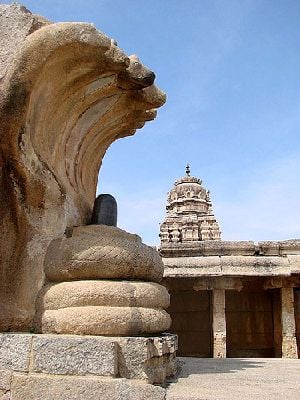
Stories involving the nāgas are still very much a part of contemporary cultural traditions in predominantly Hindu regions of Asia (India, Nepal, and the island of Bali). In India, nāgas are considered nature spirits and the protectors of springs, wells and rivers. They bring rain, and thus fertility, but are also thought to bring disasters such as floods and drought. According to traditions nāgas are only malevolent to humans when they have been mistreated. They are susceptible to mankind's disrespectful actions in relation to the environment. They are also associated with waters — rivers, lakes, seas, and wells — and are generally regarded as guardians of treasure. According to Beer (1999), Naga and cintamani are often depicted together and associated directly in the literature.
They are objects of great reverence in some parts of southern India where it is believe that they bring fertility and prosperity to their venerators.Expensive and grand rituals like Nagamandala[1] are conducted in their honour (see Nagaradhane). In north India certain communities called Nagavanshi consider themselves descendants of Nagas.
Varuna, the Vedic god of storms, is viewed as the King of the nāgas. Nāgas live in Pātāla, the seventh of the "nether" dimensions or realms.[3] They are children of Kashyapa and Kadru. Among the prominent nāgas of Hinduism are Manasa, Shesha or Sesa and Vasuki.
The nāgas also carry the elixir of life and immortality. One story mentions that when the gods were rationing out the elixir of immortality, the nāgas grabbed a cup. The gods were able to retrieve the cup, but in doing so, spilled a few drops on the ground. The nāgas quickly licked up the drops, but in doing so, cut their tongues on the grass, and since then their tongues have been forked.[citation needed]
Vishnu is originally portrayed in the form shelthered by a Shesha naga or reclining on Shesha , but the iconography has been extended to other deities as well. The serpent is a common feature in Ganesha iconography and appears in many forms: around the neck [4], use as a sacred thread (Sanskrit: yajñyopavīta)[5] wrapped around the stomach as a belt, held in a hand, coiled at the ankles, or as a throne.[6] Shiva is often shown garlanded with a snake.[7]
According to Chattampi Swamikal, a Hindu Saint, who interpreted old Tamil texts, the Nairs were Nakas (Naga or Snake) who ruled as feudal lords in the Chera kingdom. In north India certain communities called Nagavanshi consider themselves descendants of Nagas.
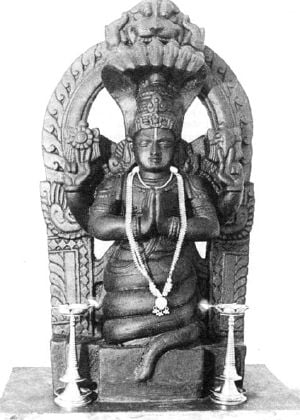
Maehle (2007: p.?) affirms that according to tradition, Patañjali is held to be an incarnation of Ādi S'esha.
Norbu (1999: p.?) states that according to tradition the Prajnaparamita terma teachings are held to have been conferred upon Nargajuna by Nagaraja, the King of the nagas, who had been guarding them at the bottom of a lake. Refer Lotus Sutra.
Nāgas in Buddhism
Traditions about nāgas are also very common in all the Buddhist countries of Asia. In many countries, the nāga concept has been merged with local traditions of large and intelligent serpents or dragons. In Tibet, the nāga was equated with the klu (pronounced lu), spirits that dwell in lakes or underground streams and guard treasure. In China, the nāga was equated with the lóng or Chinese dragon.
The Buddhist nāga generally has the form of a large cobra-like snake, usually with a single head but sometimes with many. At least some of the nāgas are capable of using magic powers to transform themselves into a human semblance. In Buddhist painting, the nāga is sometimes portrayed as a human being with a snake or dragon extending over his head. One nāga, in human form, attempted to become a monk; when telling it that such ordination was impossible, the Buddha told it how to ensure that it would be reborn a man, able to become a monk.
Nāgas are believed to both live on Mount Sumeru, among the other minor deities, and in various parts of the human-inhabited earth. Some of them are water-dwellers, living in rivers or the ocean; others are earth-dwellers, living in underground caverns. Some of them sleep on top of anthills. Their food includes frogs and they love milk.[citation needed]
The nāgas are the servants of Virūpākṣa (Pāli: Virūpakkha), one of the Four Heavenly Kings who guards the western direction. They act as a guard upon Mount Sumeru, protecting the devas of Trāyastriṃśa from attack by the Asuras.
Among the notable nāgas of Buddhist tradition is Mucalinda, protector of the Buddha.[citation needed] In the Vajrayana and Mahasiddha Traditions according to Beer (1999), many notable fully-enlightened naga also transmitted and/or transported terma into and out of the human realm that had been elementally encoded by adepts.
Well-known nāgas

- Ananta-Sesha: ("Limitless-Eternal") the world serpent with a hundred heads.
- Balarama: a nāga incarnation of Vishnu.
- Karkotaka: controls weather.
- Mucalinda: protector of the Buddha.
- Padmavati: the Nāgī queen & companion of Dharanendra.
- Paravataksha: his sword causes earthquakes and his roar caused thunder.
- Takshaka: king of the Nāgas.
- Ulupi: A companion of Arjuna in the epic Mahabharata.
- Vasuki: king of the Nagas who helped the devas recover amrita from the Ocean of Milk.
- Kaliya : A serpent conquered by Krishna
Where nāga live
- Bhoga-vita: capital of Pātāla.
- Lake Manosarowar: Lake of the Great Nāgas.
- Mount Sumeru
- Nagaland in India
- Naggar: village in the Himalayas, Tibet, that derives its name from Naga (serpent).
- Nagpur: The name of the Indian city Nagpur is derived from Nāgapuram, literally, "city of nāgas".
- Pacific Ocean: (Cambodian myth)
- Pātāla: (or Nagaloka) the seventh of the "nether" dimensions or realms.
- Sheshna's well: in Benares, India, said to be an entrance to Patala.
- Nagadaa - where naag-yaGYa was performed.
Other nāga traditions
For Malay sailors, nāgas are a type of dragon with many heads; in Thailand and Java, the nāga is a wealthy underworld deity. In Laos they are beaked water serpents. Phaya Naga Is a wellknown Dragon in Thailand.it is Phaya Nag it is a Water Dragon,people in Thailand see it as a holy creatur of the temple. They say that Phaya Nak live in mekong river.
Naga in Lake Chinni
In Malay and Orang Asli traditions, the lake Chinni, located in Pahang is home to a naga called Sri Gumum. Depending on legend versions, her predecessor Sri Pahang or her son left the lake and later fought a naga called Sri Kemboja. It should be noted that Kemboja is the former name of what is Cambodia. Like the naga legends there, there are stories about an ancient empire in lake Chinni, although the stories are not linked to the naga legends. [2], [3]
Nāgas in Cambodia
In a Cambodian legend, the nāga were a reptilian race of beings who possessed a large empire or kingdom in the Pacific Ocean region. The Nāga King's daughter married an Indian Brahmana named Kaundinya, and from their union sprang the Cambodian people. This is why, still, today, Cambodians say that they are "Born from the Nāga".
The Seven-Headed Nāga serpents depicted as statues on Cambodian temples, such as Angkor Wat, apparently represent the seven races within Nāga society, which has a mythological, or symbolic, association with "the seven colors of the rainbow". Furthermore, Cambodian Nāga possess numerological symbolism in the number of their heads. Odd-headed Nāga symbolise the Male Energy, Infinity, Timelessness, and Immortality. This is because, numerologically, all odd numbers come from One (1). Even-headed Nāga are said to be "Female, representing Physicality, Mortality, Temporality, and the Earth."
Nāgas in the Mekong
The legend of the Nāga is a strong and sacred belief held by Lao and Thai people living along the Mekong River. Many pay their respects to the river because they believe the Nāga still rule in it, and locals hold an annual sacrifice for the Nāga. Each ceremony depends on how an individual village earns its living from the Mekong River - for instance, through fishing or transport. Local residents believe that the Nāga can protect them from danger, so they are likely to make a sacrifice to Nāga before taking a boat trip along the Mekong River.
Also, every year on the night of 15th day of 11th month in the Lao lunar calendar at the end of Buddhist Lent (in 2003 it fell on October 10), an extraordinary phenomenon occurs in the area of the Mekong River stretching over 20 kilometres between Pak-Ngeum district, about 80 kilometres south of the Lao capital Vientiane, and Phonephisai district in Nong Khai province, Thailand. Fireballs spew up from the river. Everyone had doubts about this extraordinary occurrence, but later accepted what they knew as facts about the fireball: that it was not staged by humans, but happened naturally. So from then on, villagers on both sides of the river called this phenomenon the Nāga's Fireball. They believe that Nāga under Mekong River shoot the fireball into the air to celebrate the end of Buddhist Lent, because Nāga also meditate during this time.[4]
Prehistoric nāgas
Legends similar to the Cambodian legend exist amongst the tribal Hindus of Southern India (Adivasis) and the aboriginals of Australia. In this version of the legend, the Nāgas inhabited a massive continent that existed somewhere in the Pacific Ocean region.[citation needed] The warrior kshatriya community of Kerala nairs are believed to be the descendants of nagas, in their large joint home called "tharavadu" have a small forest/grove dedicated for nagas.
Notes
- ↑ For the specific terminology for cobra see p. 432, Vaman Shivram Apte, The Student's English-Sanskrit Dictionary (Motilal Banarsidass: 2002 reprint edition) ISBN 81-208-0299-3.
- ↑ Vaman Shivram Apte. A Practical Sanskrit Dictionary. p. 539. The first definition of nāgaḥ given reads "A snake in general, particularly the cobra."
- ↑ http://www.mythfolklore.net/india/encyclopedia/patala.htm
- ↑ For the story of wrapping Vāsuki around the neck and Śeṣa around the belly and for the name in his sahasranama as Sarpagraiveyakāṅgādaḥ ("Who has a serpent around his neck"), which refers to this standard iconographic element, see: Krishan, Yuvraj (1999), Gaņeśa: Unravelling An Enigma, Delhi: Motilal Banarsidass Publishers, ISBN 81-208-1413-4 pp=51-52.
- ↑ For text of a stone inscription dated 1470 identifying Ganesha's sacred thread as the serpent Śeṣa, see: Martin-Dubost, p. 202.
- ↑ For an overview of snake images in Ganesha iconography, see: Martin-Dubost, Paul (1997). Gaņeśa: The Enchanter of the Three Worlds. Mumbai: Project for Indian Cultural Studies. ISBN 81-900184-3-4. , p. 202.
- ↑ Flood, Gavin (1996). An Introduction to Hinduism. Cambridge: Cambridge University Press. ISBN 0-521-43878-0. ; p. 151
ReferencesISBN links support NWE through referral fees
- Beer, Robert (1999). The Encyclopedia of Tibetan Symbols and Motifs (Hardcover). Shambhala. ISBN-10: 157062416X, ISBN-13: 978-1570624162
- Claudia Müller-Ebeling, Claudia and Christian Rätsch and Surendra Bahadur Shahi (2002). Shamanism and Tantra in the Himalayas. Transl. by Annabel Lee. Rochester, Vt.: Inner Traditions.
- Maehle, Gregor (2007). Ashtanga Yoga: Practice and Philosophy (Paperback). New World Library. ISBN-10: 1577316061 & ISBN-13: 978-1577316060
- Norbu, Chögyal Namkhai (1999). The Crystal and The Way of Light: Sutra, Tantra and Dzogchen. Snow Lion Publications. ISBN 1-55939-135-9
External links
- Nagas in the Pali Canon
- Nagas
- Image of a Seven-Headed Naga
- Nagas and Serpents
- Depictions of Nagas in the area of Angkor Wat in Cambodia
- Snake Worship in southern India.
| Hinduism | Hindu mythology | Indian epic poetry | |
|---|---|
| Female Deities: Devi | Saraswati | Lakshmi | Sati | Parvati | Durga | Shakti | Kali | Sita | Radha | Mahavidya | more... | |
| Male Deities: Deva | Brahma | Vishnu | Shiva | Rama | Krishna | Ganesha | Murugan | Hanuman | Indra | Surya | more... | |
| Texts: Vedas | Upanishads | Puranas | Ramayana | Mahabharata | Bhagavad Gita | |
Credits
New World Encyclopedia writers and editors rewrote and completed the Wikipedia article in accordance with New World Encyclopedia standards. This article abides by terms of the Creative Commons CC-by-sa 3.0 License (CC-by-sa), which may be used and disseminated with proper attribution. Credit is due under the terms of this license that can reference both the New World Encyclopedia contributors and the selfless volunteer contributors of the Wikimedia Foundation. To cite this article click here for a list of acceptable citing formats.The history of earlier contributions by wikipedians is accessible to researchers here:
The history of this article since it was imported to New World Encyclopedia:
Note: Some restrictions may apply to use of individual images which are separately licensed.
